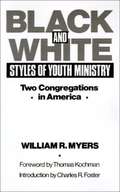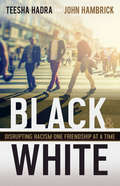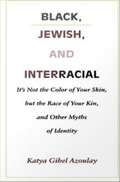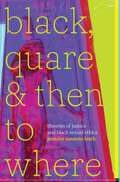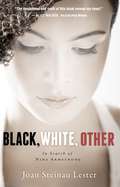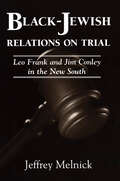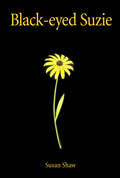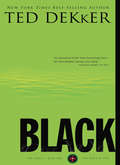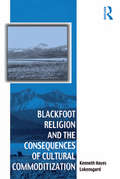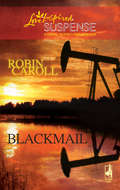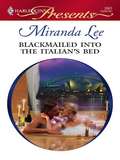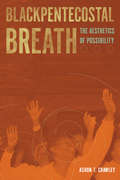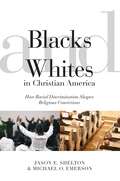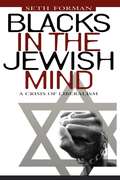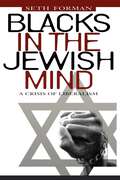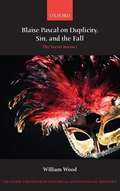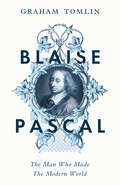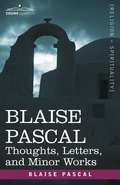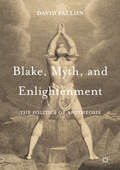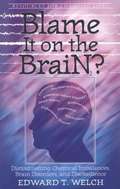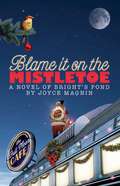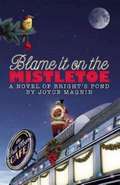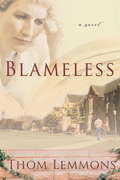- Table View
- List View
Black and White Bible, Black and Blue Wife: My Story of Finding Hope after Domestic Abuse
by Ruth A. TuckerRuth Tucker recounts a harrowing story of abuse at the hands of her husband—a well-educated, charming preacher no less—in hope that her story would help other women caught in a cycle of domestic violence and offer a balanced biblical approach to counter such abuse for pastors and counselors. Weaving together her shocking story, stories of other women, and powerful stories of husbands who truly have demonstrated Christ’s love to their wives, with reflection on biblical, theological, historical, and contemporary issues surrounding domestic violence, she makes a compelling case for mutuality in marriage and helps women and men become more aware of potential dangers in a doctrine of male headship.
Black and White Styles of Youth Ministry: Two Congregations In America
by William R. MyersBill Myers has offered a much needed picture of black and white styles of youth ministry. His own style of writing is stunning. The book is so rich in historical reflection and descriptive detail that one cannot avoid being confronted by the urgent issues of race, culture, and social history--all vitally important in shaping ministry. Mary Elizabeth Moore, School of Theology at Claremont
Black and White: Disrupting Racism One Friendship at a Time
by John Hambrick Teesha HadraWorking against racism is part of what it means to call Jesus Lord and Savior.Most of us don’t need to make speeches. We need to make friends. This is the core message of Black and White: racism can be disrupted by relationships. If you will risk forging friendships with those who do not look like you, it will change the way you see the world, and that could change the world. The authors, Teesha Hadra, a young African American woman, and John Hambrick, a sixty-year-old white man, bring a confident and redemptive tone to this hope because that is exactly what they’ve experienced. Black and White leverages their story, surrounding it with other’s stories, practical advice, and exploration of the systems of racism to motivate you to consider your own role in change. Learn about the various and often subtle ways racism continues to be a part of American culture. Discover how simple (albeit not always easy) it is to get involved in what God is doing to disrupt racism. Become equipped to take faithful, practical, next steps in obedience to God’s call to join the movement against racism. "Awareness creates discontent. A lack of awareness often results in complacency. When it comes to racism there’s no room for complacency. Especially for Christ followers. In Black & White my friends Teesha Hadra and John Hambrick stir our awareness. My hope—their hope—is that having become aware we will become permanently and passionately discontent with racism in all of its insidious forms and expressions." —Andy Stanley, pastor and founder of North Point Community Church, author of Irresistible
Black, Jewish, and Interracial: It's Not the Color of Your Skin, but the Race of Your Kin & Other Myths of Identity
by Katya Gibel AzoulayHow do adult children of interracial parents--where one parent is Jewish and one is Black--think about personal identity? This question is at the heart of Katya Gibel Azoulay's Black, Jewish, and Interracial. Motivated by her own experience as the child of a Jewish mother and Jamaican father, Gibel Azoulay blends historical, theoretical, and personal perspectives to explore the possibilities and meanings that arise when Black and Jewish identities merge. As she asks what it means to be Black, Jewish, and interracial, Gibel Azoulay challenges deeply ingrained assumptions about identity and moves toward a consideration of complementary racial identities. Beginning with an examination of the concept of identity as it figures in philosophical and political thought, Gibel Azoulay moves on to consider and compare the politics and traditions of the Black and Jewish experience in America. Her inquiry draws together such diverse subjects as Plessy v. Ferguson, the Leo Frank case, "passing," intermarriage, civil rights, and anti-Semitism. The paradoxical presence of being both Black and Jewish, she argues, leads questions of identity, identity politics, and diversity in a new direction as it challenges distinct notions of whiteness and blackness. Rising above familiar notions of identity crisis and cultural confrontation, she offers new insights into the discourse of race and multiculturalism as she suggests that identity can be a more encompassing concept than is usually thought. Gibel Azoulay adds her own personal history and interviews with eight other Black and Jewish individuals to reveal various ways in which interracial identities are being lived, experienced, and understood in contemporary America.
Black, Quare, and Then to Where: Theories of Justice and Black Sexual Ethics (Religious Cultures of African and African Diaspora People)
by jennifer susanne leathIn Black, Quare, and Then to Where jennifer susanne leath explores the relationship between Afrodiasporic theories of justice and Black sexual ethics through a womanist engagement with Maât the ancient Egyptian deity of justice and truth. Maât took into account the historical and cultural context of each human’s life, thus encompassing nuances of politics, race, gender, and sexuality. Arguing that Maât should serve as a foundation for reconfiguring Black sexual ethics, leath applies ancient Egyptian moral codes to quare ethics of the erotic, expanding what relationships and democratic practices might look like from a contemporary Maâtian perspective. She also draws on Pan-Africanism and examines the work of Alice Walker, E. Patrick Johnson, Cheikh Anta Diop, Sylvia Wynter, Sun Ra, and others. She shows that together these thinkers and traditions inform and expand the possibilities of Maâtian justice with respect to Black sexual experiences. As a moral force, leath contends, Maât opens new possibilities for mapping ethical frameworks to understand, redefine, and imagine justices in the United States.
Black, White, Other: In Search of Nina Armstrong
by Joan Steinau LesterIdentity Crisis. As a biracial teen, Nina is accustomed to a life of varied hues—mocha-colored skin, ringed brown hair streaked with red, a darker brother, a black father, a white mother. When her parents decide to divorce, the rainbow of Nina’s existence is reduced to a much starker reality. Shifting definitions and relationships are playing out all around her, and new boxes and lines seem to be getting drawn every day. Between the fractures within her family and the racial tensions splintering her hometown, Nina feels caught in perpetual battle. Feeling stranded in the nowhere land between racial boundaries, and struggling for personal independence and identity, Nina turns to the story of her great-great-grandmother’s escape from slavery. Is there direction in the tale of her ancestor? Can Nina build her own compass when landmarks from her childhood stop guiding the way?
Black-Jewish Relations on Trial: Leo Frank and Jim Conley in the New South
by Jeffrey MelnickAn analysis of the Leo Frank case as a measure of the complexities characterizing the relationship between African Americans and Jews in America In 1915 Leo Frank, a northern Jew, was lynched in Georgia. He had been convicted of the murder of Mary Phagan, a young white woman who worked in the Atlanta pencil factory managed by Frank. In a tumultuous trial in 1913 Frank's main accuser was Jim Conley, an African American employee in the factory. Was Frank guilty? In our time a martyr's aura falls over Frank as a victim of religious and regional bigotry. The unending controversy has inspired debates, movies, books, songs, and theatrical productions. Among the creative works focused on the case are a ballad by Fiddlin' John Carson, David Mamet's novel The Old Religion in 1997, and Alfred Uhry and Jason Robert Brown's musical Parade in 1998. Indeed, the Frank case has become a touchstone in the history of black-Jewish cultural relations. However, for too long the trial has been oversimplified as the moment when Jews recognized their vulnerability in America and began to make common cause with African Americans. This study has a different tale to tell. It casts off old political and cultural baggage in order to assess the cultural context of Frank's trial, and to examine the stress placed on the relationship of African Americans and Jews by it. The interpretation offered here is based on deep archival research, analyses of the court records, and study of various artistic creations inspired by the case. It suggests that the case should be understood as providing conclusive early evidence of the deep mutual distrust between African Americans and Jews, a distrust that has been skillfully and cynically manipulated by powerful white people. Black-Jewish Relations on Trial is concerned less with what actually happened in the National Pencil Company factory than with how Frank's trial, conviction, and lynching have been used as an occasion to explore black-Jewish relations and the New South. Just as with the O. J. Simpson trial, the Frank trial requires that Americans make a profound examination of their essential beliefs about race, sexuality, and power.
Black-eyed Suzie
by Susan ShawSuzie is a dark-eyed twelve-year-old who desperately needs to feel safe and worthy of love. Seeking only to be "good enough," she remains motionless and silent for hours on end, feeling the walls of her psychological prison pressing against her. Ultimately, Suzie finds herself in a mental hospital where she begins a long and fear-filled journey. To make sense of her world, Suzie must piece together a puzzle that involves seemingly unrelated clues--a broken bicycle, a torn picture, peacock feathers, and more--which together reveal a secret that is likely to change Suzie's life forever, and give her an opportunity to regain her voice and reclaim here spirit.
Black: The Circle Series
by Ted DekkerAn Adrenaline-Laced Epic Where Dreams and Reality Collide. Fleeing assailants through deserted alleyways, Thomas Hunter narrowly escapes to the roof of a building. Then a silent bullet from the night clips his head . . . and his world goes black. From the blackness comes an amazing reality of another world where evil is contained. A world where Thomas Hunter is in love with a beautiful woman. But then he remembers the dream of being chased through an alleyway as he reaches to touch the blood on his head. Where does the dream end and reality begin? Every time he falls asleep in one world, he awakes in the other. Yet in both, catastrophic disaster awaits him . . . may even be caused by him. Some say the world hangs in the balance of every choice we make. Now the fate of two worlds hangs in the balance of one man's choices.
Blackfoot Religion and the Consequences of Cultural Commoditization (Vitality of Indigenous Religions)
by Kenneth Hayes LokensgardThis book explores the exchange of Blackfoot "medicine bundles" within contemporary Blackfoot culture and between the Blackfoot Peoples and Euro-Americans. These ceremonial bundles, which are circulated as gifts in their native context, are robbed of their statuses as living beings or persons, when they are treated as symbolic objects or commodities by cultural outsiders. Much of the original, ethnographic data presented in this book deals with the attempts of some Blackfeet to repatriate ceremonial materials from Euro-American hands. This book represents a valuable study of contemporary Blackfoot religion as well as the repatriation movement. Kenneth Lokensgard also contributes to the studies of material culture and exchange; central to his investigation is the critical examination and reapplication of the interpretative terms "gift" and "commodity." Careful use of these terms, Lokensgard argues, can better help scholars appreciate how different peoples perceive the worlds they inhabit.
Blackmail
by Robin CarollAnother facility's been sabotaged! And PR representative Sadie Thompson is on the case. When she's assigned to investigate the damage to her employer's oil rigs, she knows it's her chance. Finally, she can prove she's left her "bad girl" past behind her. Yet someone wants the evidence to disappear--and is willing to threaten Sadie and Caleb, her recently paroled half-brother, to make it happen. Caleb's parole officer, Jon Garrison, is watching them both closely, waiting for one of them to slip up. He doesn't trust Sadie--can she trust him? She needs Jon's help, and has nowhere else to turn. . . .
Blackmailed into the Italian's Bed (Bedded by Blackmail #12)
by Miranda LeeJordan has struggled to forget Gino Bortelli,the arrogant, sexy Italian with whom she hadan affair ten years before. Things had endedabruptly, but Jordan still craved Gino's touch.No man yet had made her feel as Gino had....Now he's back! Older, richer and sexier, Ginostill has the power to make Jordan melt. Heknows something Jordan would prefer bekept secret and he's prepared to use it-tohave her, bed her, any way he wants her. And, to Jordan's shame, she can't say no....
Blackpentecostal Breath: The Aesthetics of Possibility (Commonalities)
by Ashon T. CrawleyIn this profoundly innovative book, Ashon T. Crawley engages a wide range of critical paradigms from black studies, queer theory, and sound studies to theology, continental philosophy, and performance studies to theorize the ways in which alternative or “otherwise” modes of existence can serve as disruptions against the marginalization of and violence against minoritarian lifeworlds and possibilities for flourishing.Examining the whooping, shouting, noise-making, and speaking in tongues of Black Pentecostalism—a multi-racial, multi-class, multi-national Christian sect with one strand of its modern genesis in 1906 Los Angeles—Blackpentecostal Breath reveals how these aesthetic practices allow for the emergence of alternative modes of social organization. As Crawley deftly reveals, these choreographic, sonic, and visual practices and the sensual experiences they create are not only important for imagining what Crawley identifies as “otherwise worlds of possibility,” they also yield a general hermeneutics, a methodology for reading culture in an era when such expressions are increasingly under siege.
Blacks and Whites in Christian America: How Racial Discrimination Shapes Religious Convictions (Religion and Social Transformation #5)
by Michael Oluf Emerson Jason E. Shelton2012 Winner of the C. Calvin Smith Award presented by the Southern Conference on African American Studies, Inc. 2014 Honorable Mention for the Distinguished Book Award presented by the American Sociological Association's Sociology of Religion Section Conventional wisdom holds that Christians, as members of a“universal” religion, all believe more or less the same thingswhen it comes to their faith. Yet black and white Christiansdiffer in significant ways, from their frequency of praying orattending services to whether they regularly read the Bible orbelieve in Heaven or Hell.In this engaging and accessible sociological study of whiteand black Christian beliefs, Jason E. Shelton and Michael O.Emerson push beyond establishing that there are racial differencesin belief and practice among members of AmericanProtestantism to explore why those differences exist. Drawingon the most comprehensive and systematic empiricalanalysis of African American religious actions and beliefsto date, they delineate five building blocks of black Protestantfaith which have emerged from the particular dynamicsof American race relations. Shelton and Emerson find thatAmerica’s history of racial oppression has had a deep andfundamental effect on the religious beliefs and practices ofblacks and whites across America.
Blacks in the Jewish Mind: A Crisis of Liberalism
by Seth FormanSince the 1960s the relationship between Blacks and Jews has been a contentious one. While others have attempted to explain or repair the break-up of the Jewish alliance on civil rights, Seth Forman here sets out to determine what Jewish thinking on the subject of Black Americans reveals about Jewish identity in the U.S. Why did American Jews get involved in Black causes in the first place? What did they have to gain from it? And what does that tell us about American Jews? In an extremely provocative analysis, Forman argues that the commitment of American Jews to liberalism, and their historic definition of themselves as victims, has caused them to behave in ways that were defined as good for Blacks, but which in essence were contrary to Jewish interests. They have not been able to dissociate their needs--religious, spiritual, communal, political--from those of African Americans, and have therefore acted in ways which have threatened their own cultural vitality. Avoiding the focus on Black victimization and white racism that often infuses work on Blacks and Jews, Forman emphasizes the complexities inherent in one distinct white ethnic group's involvement in America's racial dilemma.
Blacks in the Jewish Mind: A Crisis of Liberalism
by Seth FormanSince the 1960s the relationship between Blacks and Jews has been a contentious one. While others have attempted to explain or repair the break-up of the Jewish alliance on civil rights, Seth Forman here sets out to determine what Jewish thinking on the subject of Black Americans reveals about Jewish identity in the U.S. Why did American Jews get involved in Black causes in the first place? What did they have to gain from it? And what does that tell us about American Jews? In an extremely provocative analysis, Forman argues that the commitment of American Jews to liberalism, and their historic definition of themselves as victims, has caused them to behave in ways that were defined as good for Blacks, but which in essence were contrary to Jewish interests. They have not been able to dissociate their needs--religious, spiritual, communal, political--from those of African Americans, and have therefore acted in ways which have threatened their own cultural vitality. Avoiding the focus on Black victimization and white racism that often infuses work on Blacks and Jews, Forman emphasizes the complexities inherent in one distinct white ethnic group's involvement in America's racial dilemma.
Blaise Pascal on Duplicity, Sin, and the Fall: The Secret Instinct
by William WoodPascal holds that as fallen selves in a fallen world, human beings have an innate aversion to the truth that is also, at the same time, an aversion to God. According to Pascal, we are born into a duplicitous world that shapes us into duplicitous subjects, and so we find it easy to reject God continually and deceive ourselves about our own sinfulness. Pascal's account of the noetic effects of sin has long been overlooked by theologians, but it is both traditional and innovative.
Blaise Pascal: The Man Who Made the Modern World
by Graham Tomlin'Readable and expert - a brilliant guide to the life and thought of 17th century Europe's supreme polymath'Tom Holland'A richly detailed account of Pascal's life and times, which displays an energetic sympathy for Pascal's startling combination of intellectual precocity and humble faith.'Rory Stewart'A beautiful, accessible account of one of the era's most remarkable lives'Katherine Rundell He lived for just 39 years, yet Blaise Pascal was one of the most remarkable and creative figures of the seventeenth century. He is known for his famous (though often misunderstood) argument 'the Wager', but there's so much more to him than that. Pascal can lay claim to have built an early version of the modern computer, done ground-breaking work in mathematics and geometry, invented urban bus transport and virtually invented probability theory. He also produced one of the most haunting and effective works of Christian apologetics ever written. He is a major intellectual figure at the beginning of the modern age who blends together in his own person and thinking issues that are critical to our age. Blaise Pascal is therefore a crucial figure: not just in the history of European thought, but for how he can shed light on our many contemporary debates.From science to scepticism; mystical experience to distraction; religion to politics, self-love and death, Pascal's thinking was far-reaching. In this captivating biography, Graham Tomlin explores Pascal's short but extraordinary life, and the sweeping impact and relevance of his ideas to the modern world.
Blaise Pascal: The Man Who Made the Modern World
by Graham Tomlin'Readable and expert - a brilliant guide to the life and thought of 17th century Europe's supreme polymath'Tom Holland'A richly detailed account of Pascal's life and times, which displays an energetic sympathy for Pascal's startling combination of intellectual precocity and humble faith.'Rory Stewart'A beautiful, accessible account of one of the era's most remarkable lives'Katherine Rundell He lived for just 39 years, yet Blaise Pascal was one of the most remarkable and creative figures of the seventeenth century. He is known for his famous (though often misunderstood) argument 'the Wager', but there's so much more to him than that. Pascal can lay claim to have built an early version of the modern computer, done ground-breaking work in mathematics and geometry, invented urban bus transport and virtually invented probability theory. He also produced one of the most haunting and effective works of Christian apologetics ever written. He is a major intellectual figure at the beginning of the modern age who blends together in his own person and thinking issues that are critical to our age. Blaise Pascal is therefore a crucial figure: not just in the history of European thought, but for how he can shed light on our many contemporary debates.From science to scepticism; mystical experience to distraction; religion to politics, self-love and death, Pascal's thinking was far-reaching. In this captivating biography, Graham Tomlin explores Pascal's short but extraordinary life, and the sweeping impact and relevance of his ideas to the modern world.
Blaise Pascal: Thoughts, Letters, And Minor Works
by Blaise PascalWhile the title indicates this volume included "Thoughts", in fact it includes only the Letters and Minor Works sections of the original work, starting at page 325.
Blake, Myth, and Enlightenment: The Politics of Apotheosis
by David FallonThis book provides compelling new readings of William Blake's poetry and art, including the first sustained account of his visionary paintings of Pitt and Nelson. It focuses on the recurrent motif of apotheosis, both as a figure of political authority to be demystified but also as an image of utopian possibility. It reevaluates Blake's relationship to Enlightenment thought, myth, religion, and politics, from The French Revolution to Jerusalem and The Laoco#65533;n. The book combines careful attention to cultural and historical contexts with close readings of the texts and designs, providing an innovative account of Blake's creative transformations of Enlightenment, classical, and Christian thought.
Blame It On The Brain?: Distinguishing Chemical Imbalances, Brain Disorders, And Disobedience (Resources For Changing Lives Ser.)
by Edward T. WelchDepression, Attention Deficit Disorder, Alcoholism, Homosexuality. Research suggests that more and more behaviors are caused by brain function or dysfunction. But is it ever legitimate to blame misbehavior on the brain? How can I know whether ?My brain made me do it Viewing brain problems through the lens of Scripture, Edward T. Welch distinguishes genuine brain disorders from problems rooted in the heart. Understanding that distinction will enable pastors, counselors, families, and friends to help others-or themselves-deal with personal struggles and responsibilities. While focusing on a few common disorders, Dr. Welch lays out a series of practical steps adaptable to a wide range of conditions, habits, or addictions.
Blame It On The Mistletoe
by Joyce MagninWelcome back to Bright's Pond, where strange happenings are afoot at the Greenbrier Nursing Home. The folks have suddenly grown younger, happier, and even a bit friskier thanks to Leon Fontaine, the newest Paradise Trailer Park resident. But Mildred Blessing is suspicious and sets out to investigate while the wedding to end all weddings is being planned. Only, in Bright's Pond, nothing ever really goes as planned . . .
Blame It On The Mistletoe - A Novel of Bright's Pond
by Joyce MagninIs There Really a Fountain of Youth in Paradise? Welcome back to Bright's Pond, where strange happenings are afoot at the Greenbrier Nursing Home. The folks have suddenly grown younger, happier, and even a bit friskier thanks to Leon Fontaine, the newest Paradise Trailer Park resident. But Mildred Blessing is suspicious and sets out to investigate while the wedding to end all weddings is being planned. Only, in Bright's Pond, nothing ever really goes as planned . . . "What's better than Bright's Pond? Bright's Pond at Christmas time. Magnin hasn't just created characters--she's created friends you'll love spending time with. You'll love every page of this quirky delight, and when that last chapter is read, you'll be ready for more of Griselda and the rest of the Bright's Pond residents." - Jenny B. Jones, Award-winning author of romantic comedies such as" Save the Date" and A Charmed Life series "The queen of quirk does it again. With her signature wit and charm and penchant for surprise, Joyce Magnin takes us on a leisurely read through Bright's Pond, where uncannily loveable chaeracters reside -- God in the midst of them. I want to move there." - Nancy Rue, author of The Reluctant Prophet "Creative and fun, a visit to Bright 's Pond for the Holidays is just what the doctor ordered. Who can resist spry octogenarians in hot pursuit of the Fountain of Youth or romance in trouble But it is the endearing thread of love and sympathy that runs through the characters that makes readers return." - Cathy Gohlke, Christy Award winning author of William Henry is a Fine Name and I Have Seen Him in the Watchfires
Blameless
by Thom LemmonsIs it possible to find unconditional love in a world of expectations? Professor Joseph Barnes is attractive, intelligent, and successful-beloved by both his students and fellow university faculty. Despite her professional reservations, Alexis, the dean of Joe's college, finds herself drawn to him and recognizes his interest in her. But when Joe's career begins to crumble, Alexis has to decide whether or not to rescue Joe from his circumstances. If she does save him, how can she be sure he loves her for herself-and not for what she can do for him? Can she fight the ghosts of the past that haunt them both? Three well-intentioned friends and an ambitious department secretary complicate the delicate situation between Alexis and Joe in this modern retelling of the biblical story of Job. Thoughtful and clever, Blameless asks, what does it mean to love without expectations? And in the midst of losing it all, is it possible to find everything you've been looking for?

